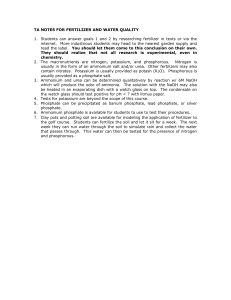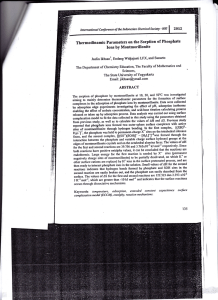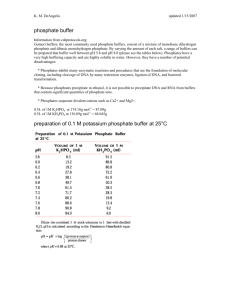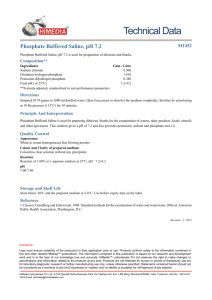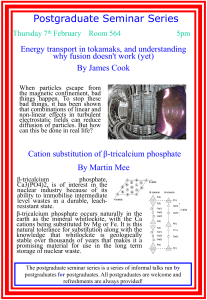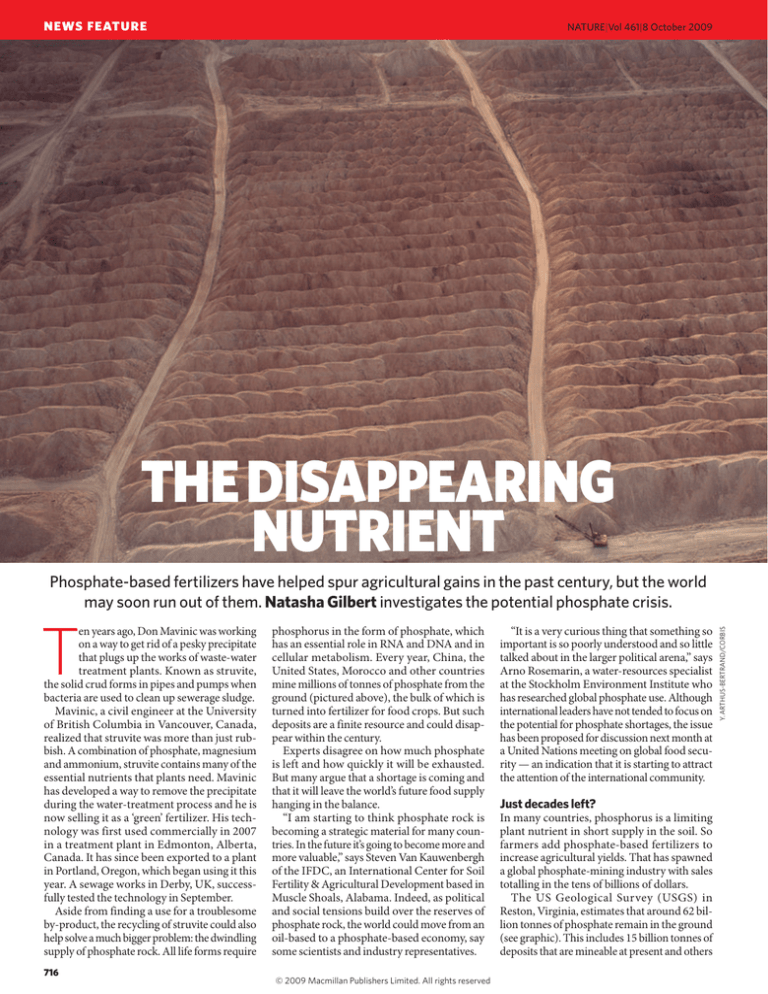
NEWS FEATURE
Vol 461|8 October 2009
NATURE|Vol
THE DISAPPEARING
NUTRIENT
T
en years ago, Don Mavinic was working
on a way to get rid of a pesky precipitate
that plugs up the works of waste-water
treatment plants. Known as struvite,
the solid crud forms in pipes and pumps when
bacteria are used to clean up sewerage sludge.
Mavinic, a civil engineer at the University
of British Columbia in Vancouver, Canada,
realized that struvite was more than just rubbish. A combination of phosphate, magnesium
and ammonium, struvite contains many of the
essential nutrients that plants need. Mavinic
has developed a way to remove the precipitate
during the water-treatment process and he is
now selling it as a ‘green’ fertilizer. His technology was first used commercially in 2007
in a treatment plant in Edmonton, Alberta,
Canada. It has since been exported to a plant
in Portland, Oregon, which began using it this
year. A sewage works in Derby, UK, successfully tested the technology in September.
Aside from finding a use for a troublesome
by-product, the recycling of struvite could also
help solve a much bigger problem: the dwindling
supply of phosphate rock. All life forms require
716
phosphorus in the form of phosphate, which
has an essential role in RNA and DNA and in
cellular metabolism. Every year, China, the
United States, Morocco and other countries
mine millions of tonnes of phosphate from the
ground (pictured above), the bulk of which is
turned into fertilizer for food crops. But such
deposits are a finite resource and could disappear within the century.
Experts disagree on how much phosphate
is left and how quickly it will be exhausted.
But many argue that a shortage is coming and
that it will leave the world’s future food supply
hanging in the balance.
“I am starting to think phosphate rock is
becoming a strategic material for many countries. In the future it’s going to become more and
more valuable,” says Steven Van Kauwenbergh
of the IFDC, an International Center for Soil
Fertility & Agricultural Development based in
Muscle Shoals, Alabama. Indeed, as political
and social tensions build over the reserves of
phosphate rock, the world could move from an
oil-based to a phosphate-based economy, say
some scientists and industry representatives.
© 2009 Macmillan Publishers Limited. All rights reserved
“It is a very curious thing that something so
important is so poorly understood and so little
talked about in the larger political arena,” says
Arno Rosemarin, a water-resources specialist
at the Stockholm Environment Institute who
has researched global phosphate use. Although
international leaders have not tended to focus on
the potential for phosphate shortages, the issue
has been proposed for discussion next month at
a United Nations meeting on global food security — an indication that it is starting to attract
the attention of the international community.
Just decades left?
In many countries, phosphorus is a limiting
plant nutrient in short supply in the soil. So
farmers add phosphate-based fertilizers to
increase agricultural yields. That has spawned
a global phosphate-mining industry with sales
totalling in the tens of billions of dollars.
The US Geological Survey (USGS) in
Reston, Virginia, estimates that around 62 billion tonnes of phosphate remain in the ground
(see graphic). This includes 15 billion tonnes of
deposits that are mineable at present and others
Y. ARTHUS-BERTRAND/CORBIS
Phosphate-based fertilizers have helped spur agricultural gains in the past century, but the world
may soon run out of them. Natasha Gilbert investigates the potential phosphate crisis.
that are not being exploited. The latter are left
in the ground mainly because they contain too
many impurities — such as cadmium and other
toxic metals — or because they are offshore in
difficult-to-reach places.
In 2008, 161 million tonnes of phosphate
was mined around the world, according to
the latest, as yet unpublished, figures from the
US Geological Survey. Stephen Jasinski, phosphate-rock commodities expert at the survey,
says that demand for fertilizers is predicted to
grow by 2.5-3% per year for the next 5 years. If
that rate continues, the world’s reserves should
last for around 125 years.
That is a relatively optimistic timescale,
but it is echoed by the International Fertilizer
Industry Association in Paris, whose members
include 90% of the world’s fertilizer producers.
Michel Prud’homme, executive secretary of
the association’s Production and International
Trade Committee, says that the industry anticipates that demand for fertilizers will grow at a
“fairly moderate rate”, slowing by the middle of
the century. That would enable reserves to last
for at least another 100 years.
But others predict a faster growth in demand
for fertilizers, which would deplete phosphate
reserves even quicker. The increased use will be
driven in part by the rising global population,
which will require food production to at academics and other minerals specialists to
least double by 2050, according to the Food collect extensive data on how much phosand Agricultural Organization of the United phate there is, how pure it is, what might be
available in the future and the useful life of
Nations (FAO).
Rosemarin and others say that nations should existing mines. Van Kauwenbergh, who is
not rely on the reserves laden with impurities leading the project, expects to publish the first
or located offshore because of the costs — both round of data in May next year. If the centre
environmental and economic — of extracting secures more funding, he hopes to continue the
usable phosphate. The remaining accessible research for another 5 years.
reserves of clean phosphate rock would run out
The USGS figures on phosphate reserves are
in 50 years, if growth stays at 3% per year, says the most-quoted publicly available information. But there are problems
Rosemarin.
But the estimates all suffer
“I am starting to think with them because the agency
from a lack of reliable data.
gets its information from forphosphate rock is
Most of the world’s phosphateeign governments, not directly
becoming a strategic
mining companies are intefrom producers, and it is not
independently verified. “We
grated with fertilizer firms and
material for many
the mines are either owned by
just don’t know how good the
countries.” — Steven USGS data are because they
the companies or are under
Van Kauwenbergh
state control, says Prud’homme.
are based on second and thirdAs a result, it is difficult to get
hand information. The figures
accurate, independent information on phos- change all the time,” says Van Kauwenbergh.
phate reserves.
Some people who track the phosphate indusEric Kueneman, deputy director of the FAO’s try say that there is no cause for concern about
plant production and protection division says, phosphate running out. “I don’t think this is an
“the reality is we as a public institution don’t immediate crisis, but it is something we should
really know what the industry knows and nor be paying attention to,” says Jasinski.
do they know among themselves. To give a reliPrud’homme is sanguine about prospects
able answer to the question, ‘will phosphates for the future. If demand rises, then so will
run out?’, we need a crystal ball.”
prices, he says, allowing companies to explore
The International Fertilizer Industry Asso- for new reserves and mine those that are harder
ciation collects data from its members on their to reach or from a lower grade of rock. “We
existing reserves and on potential upcoming feel there are enough reserves to meet food and
capacity. But some experts question the accu- material needs,” he says.
racy of these data because they are supplied by
For example, companies have recently begun
producers who might be disinclined to provide to investigate deposits in Peru, Australia and
proprietary information that could harm their off the coast of Namibia that were not previously considered financially viable, says
commercial positions.
Prud’homme. These resources are not fully
taken into account in the most recent USGS
No agreement
There is also a lot of uncertainty over the data figures on world phosphate reserves, he says.
supplied by governments, which is the case And as some existing mines are tapped out,
with China and Morocco, says Dana Cordell, others are opening up in places such as Saudi
who has just completed her doctoral thesis on
the effect of phosphate reserves on food secuTHE WORLD'S REMAINING
rity at the University of Technology Sydney in
PHOSPHATES
Australia. For example, when China joined
(Gt = gigatonnes)
the World Trade Organization in 2001, its
reported reserves of phosphate rock instantly
United
jumped from just over 2 billion tonnes to
States
Rest of
1
4.6 Gt
nearly 8 billion tonnes .
the world
Cordell and Kueneman call for independent
12.6 Gt
China
data collection on phosphate rock reserves.
14.1 Gt
South Africa
“Unlike for energy, water or nitrogen, there is
4 Gt
no single international organization responsible for phosphate resources. That is very
concerning,” Cordell says.
Morocco and
Western Saraha
The IFDC hopes to generate more solid
26.7 Gt
data about the extent of the world’s phosphate
resources and reserves. It will soon launch a
project that will query phosphate producers,
© 2009 Macmillan Publishers Limited. All rights reserved
717
SOURCE: USGC
NEWS FEATURE
Vol 461|8 October
NATURE|Vol
461|82009
October 2009
NEWS FEATURE
Arabia. “I am convinced there are other sources
we have not yet found, but it is difficult to say
how much impact these will have,” he says.
Others are sceptical that further exploration
will uncover large new deposits or that they
will solve the longer-term problem. “We are
not going to find another Morocco,” says Jasinski, referring to the country with the biggest
remaining reserves.
In the meantime, companies have started to
invest in new technologies to exploit the lowergrade and offshore deposits. The impetus for
this move into more costly production was the
hike in phosphate rock prices in 2008, when the
value temporarily spiked at US$500 per tonne,
more than five times the average price in 2007
(ref. 2). Prices had remained comparatively
flat for the previous five years. The price hike
was due to tight supplies of the rock caused by
increased demand for phosphate-based fertilizers in India and China as well as record energy
prices. Phosphate prices have since dropped
back to their pre-spike levels.
Few alternatives
CLEAN WATER SERVICES
Despite the investments in unconventional
reserves, those deposits may not be viable in
the long term. Jan-Olof Drangert, an expert
in water and land resources at Linköping
University in Sweden, says that lower-grade
reserves are “not a solution” if the world wants
a sustainable system. Not only will extracting
lower-grade phosphates be very expensive, it
will also pollute the soils with cadmium, which
is highly toxic to plant and animal life even
in low doses, he says. “And then there is still
the problem of exhausting these lower-grade
reserves,” he adds.
The increase in demand for fertilizer in
2008 may have been a taste of things to come,
especially if demand for food rises as fast as
some estimates suggest. The price hike last year
“was a huge shock to farmers”, says Cordell.
Fertilizers had to be rationed in some cases.
“The bottom line is that it will just cost more
to eat,” says Rosemarin. “There will be no cheap
lunches any more.”
Struvite build-up in water-treatment pipes could
be a valuable source of phosphate.
718
Vol 461|8 October 2009
NATURE|Vol
Making fertilizers go further
No matter how much
phosphate is left to be
extracted from the ground,
cutting down on the use of
phosphate-based fertilizers
and improving their efficiency
could make a significant
improvement, says Alan
Townsend, a biogeochemist
at the University of Colorado
in Boulder. “Fertilizer is seen
as a cheap insurance policy.
Farmers tend to overuse it
because they don’t want to be
caught out,” he says.
In the past two decades, the
United States and Europe have
reduced the widespread
over-application of fertilizers,
but that strategy continues
to be a problem in other parts
of the world, says Townsend.
One of the biggest culprits
is China5, where farmers are
applying nearly twice as much
fertilizer as is needed in the
production of wheat.
Experts disagree, however,
on whether excess fertilizer
application is actually
unwarranted. Tony Vyn,
an agronomist at Purdue
University in West Lafayette,
Indiana, says that the overuse
of fertilizers in the European
Union and United States has
built up phosphate reserves
in the soil. Farmers are now
taking advantage of that
by applying less phosphate
than the crops actually need
each year. So the strategy of
China’s farmers may not be
unreasonable, he says.
Other gains toward
preserving phosphate
resources could come through
improved industrial practices.
Between 40% and 60% of
phosphate is lost when its
host rock is converted to
fertilizer. Researchers are
now looking to reduce that
N.G.
wastage.
The uncertainty over the world’s phosphate produce enough fertilizer to meet about 30%
reserves is compounded by the fact that sup- of its current needs.
ply is concentrated is just a few hands. China,
That pales, however, when compared with a
Morocco, the United States and Russia together much richer — and more pungent — source of
hold more than 70% of the global phosphate phosphate: the manure generated by dairy and
deposits3, presenting the possibility of “market pig farming. Livestock waste contains around
manipulation”, says Amit Roy, president of the five times more phosphate than human waste.
IFDC.
And the global livestock population is around
Evidence of strategic manoeuvring can 65 billion, more than ten times the human
already be seen. In March 2004, the United population. There is “enormous potential” for
States and Morocco signed
recovering phosphates from
a free-trade agreement that
livestock waste, says Mavinic,
“There is no single
covered phosphate rock,
who has turned his attention
international
among other commodities.
to doing just that.
organization
In 2008, Morocco exported
The problem his research
$65-million worth of fertiteam is trying to solve is that
responsible
for
lizer to the United States 4.
in livestock waste
phosphate resources.” phosphates
Although the United States
are not in a dissolved form,
— Dana Cordell which is necessary to make
has one of the world’s largest
struvite. If programmes to
phosphate rock reserves, the
nation will see a significant drop in production recover phosphates from livestock waste sucin 25 years when it is estimated that produc- ceed, “the sky is the limit”, says Mavinic. “We
tion will peak at its key mines in Florida. The would probably not have to import any fertilizer
deal with Morocco, says Rosemarin, is aimed into this country.”
at securing the United State’s future fertilizer
But all this takes time. Decades may pass
and food supply.
before recycling technologies gear up and new
In the case of some finite resources, such as supplies of phosphate come on line. At present,
oil, alternatives can be found. But there are cur- nations have expressed little concern over the
rently no substitutes for phosphates. Cutting finite phosphate resource and are eagerly conusage will help to make reserves last longer (see suming reserves. When solutions do eventually
‘Making fertilizers go further’).
emerge, the world could already be in the grip
But most agree that some of the biggest gains of a fertilizer and food shortage.
■
will probably be made from the recovery and Natasha Gilbert is a reporter based in Nature’s
recycling of phosphates, such as Mavinic’s London office.
work mining the phosphate deposits inside 1. Rosemarin, A. Down to Earth June, 27–31 (2004)..
water-treatment plants. In a back-of-the- 2. USGS Mineral Commodity Summaries: Phosphate Rock
(USGS, 2009).
envelope calculation, he estimates that if all
Global Phosphate Reserves, Resources and Future
domestic wastewater facilities in Canada 3. IFDC
Production (IFDC, 2008).
were converted into biological treatment sys- 4. http://www.moroccousafta.com/tradedata.htm
tems using his technology, the country could 5. Vitousek, P. M. et al. Science 324, 1519–1520 (2009).
© 2009 Macmillan Publishers Limited. All rights reserved


